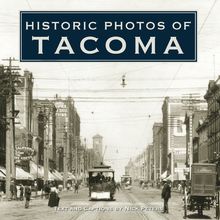Historic Photos of Lake Michigan , livre ebook
181
pages
English
Ebooks
2009
Vous pourrez modifier la taille du texte de cet ouvrage
Obtenez un accès à la bibliothèque pour le consulter en ligne En savoir plus
Découvre YouScribe en t'inscrivant gratuitement
Découvre YouScribe en t'inscrivant gratuitement
181
pages
English
Ebooks
2009
Vous pourrez modifier la taille du texte de cet ouvrage
Obtenez un accès à la bibliothèque pour le consulter en ligne En savoir plus
Publié par
Date de parution
01 septembre 2009
Nombre de lectures
1
EAN13
9781618584007
Langue
English
Poids de l'ouvrage
9 Mo
The vast lingering remnant of an ice age that came to a close more than 10,000 years ago, Lake Michigan has shaped the history of the settlements along its surrounding shores for centuries. Its storied waters have seen schooners, luxury steamships, and modern freighters, its lakeshores the rise of the railroads that helped to carve a way of life into the surrounding wooded wilderness for the Americans who called the region home. Through high times and lean, the lake’s 1,640 miles of coastline have clung to their untamed beauty even as bustling harbor hamlets and booming cities like Chicago and Milwaukee rose in their midst.
Historic Photos of Lake Michigan chronicles portions of two centuries on and around Lake Michigan—the only great lake entirely within United States borders, the third-largest of the five Great Lakes, and the fifth-largest freshwater lake in the world—showcasing the ever-changing life and landscape along its quartz crystal coast.
Publié par
Date de parution
01 septembre 2009
Nombre de lectures
1
EAN13
9781618584007
Langue
English
Poids de l'ouvrage
9 Mo
HISTORIC PHOTOS OF
LAKE MICHIGAN
T EXT AND C APTIONS BY L YNDA T WARDOWSKI
Sheboygan County s Crystal Lake, pictured here in 1912, is one reservoir of the 75-mile Sheboygan River, which empties into Lake Michigan at Milwaukee.
HISTORIC PHOTOS OF
LAKE MICHIGAN
Turner Publishing Company
200 4th Avenue North Suite 950
Nashville, Tennessee 37219
(615) 255-2665
www.turnerpublishing.com
Historic Photos of Lake Michigan
Copyright 2009 Turner Publishing Company
All rights reserved.
This book or any part thereof may not be reproduced or transmitted in any form or by any means, electronic or mechanical, including photocopying, recording, or by any information storage and retrieval system, without permission in writing from the publisher.
Library of Congress Control Number: 2009921193
ISBN: 978-1-59652-532-0
Printed in China
09 10 11 12 13 14 15 16-0 9 8 7 6 5 4 3 2 1
C ONTENTS
A CKNOWLEDGMENTS
P REFACE
S ETTLEMENT OF THE G REAT W ATER (1861-1880)
T HROUGH T IMBER B OOM AND B UST (1881-1900)
C RESTS AND T ROUGHS (1901-1929)
H ARD T IMES AND P OSTWAR P ROSPERITY (1930-1965)
N OTES ON THE P HOTOGRAPHS
A floating boardinghouse and tug in the harbor of Elk Rapids, Michigan-likely those of the firm Dexter Noble, who owned an immense timber operation in the village. Floating boardinghouses typically served two purposes: transporting logs tied together in rafts-a safer method than driving separated logs-and housing the men who rafted the logs.
A CKNOWLEDGMENTS
This volume, Historic Photos of Lake Michigan , is the result of the cooperation and efforts of many individuals and organizations. It is with great thanks that we acknowledge the valuable contribution of the following for their generous support:
Bentley Historic Library
Library of Congress
Wisconsin Historical Society
-------
With the exception of touching up imperfections that have accrued with the passage of time and cropping where necessary, no changes have been made. The focus and clarity of many images are limited to the technology and the ability of the photographer at the time they were recorded.
P REFACE
Imagine, if you can, a time when Lake Michigan didn t exist. Nearly 20,000 years ago, it didn t-not a drop. Where now there is a freshwater vastness of cerulean blue, there was then nothing but a gigantic white sheet of ice, nearly two miles thick. The ice would ultimately vanish without a trace, but an indelible map of the glacier s existence on the earth was etched into the terrain beneath. As the world around it warmed, the glacier retreated, carving deep gouges-the deepest of which would become enormous basins into which the glacial melt would pour, filling them and falling, then rising and falling again as the land and water worked to find balance over the next 10,000 years.
The Lake Michigan we know today, more than 100 miles wide, 300 miles long, and filled with nearly 1,180 cubic miles of water, took more than 6,000 years to ease into its current shape and volume. But glacially slow though its first 200 centuries moved, this third-largest of the Great Lakes, in recent centuries, seems to have evolved as quickly as a sudden Lake Michigan storm can chase away the sun.
Ancient peoples and Woodland Indians settled early on the dried landscape beside the new waters, and European explorers followed in the early seventeenth century. French explorer Jean Nicolet is considered the first European to discover Lake Michigan, but he would not be the last to traverse its waters and coast. Louis Jolliet, Jacques Marquette, and Robert de La Salle and a host of traders and missionaries came to the region, one after another, establishing scores of small ports and settlements along the coast through the late seventeenth and eighteenth centuries.
Some say the first permanent settlement on Lake Michigan was at the site of present-day Chicago by Jean Baptiste Point du Sable in 1779; others assert Green Bay has a rightful claim to that distinction, noting the mission established by Father Allouez in present-day Green Bay, Wisconsin, in 1669. Much like its bitterly contested claims to firsts, the Lake Michigan region, as part of the resource-rich Northwest Territory, inspired countless battles for control between the French, English, and Native Americans, but by 1796 it was in the hands of the newly formed United States-and the American way of growth, expansion, and innovation would kick-start the nineteenth century s progress along the Lake Michigan shoreline like none before.
With Lake Michigan as the anchor to trade throughout the otherwise remote and largely isolated region, ships plied its waters, giving birth to city after city along its coast. The year 1837 brought the founding of Chicago, Illinois. The city of Manistee, Michigan, was founded four years later. Milwaukee, Wisconsin, settled since 1818, officially became a city in 1846. Green Bay followed in 1854. The growth in commerce spurred the cities on, fueling their expansion and attracting waves of immigrants seeking a livelihood and making their way from the Atlantic Coast to the burgeoning cities, farms, and orchards around Lake Michigan. As time advanced, so too did technology, bringing steam power to Lake Michigan s ships, then to the railroad lines stretching out along its shores. Timber from Michigan s hinterlands was shipped to build (and, in some cases, rebuild) growing cities along the lake s western coast. In return, the west coast cities and ports shipped beef and grain from their outlying farming regions east to Michigan and beyond.
By the early 1900s, lumbering had reached its peak and bottomed out, felling many a boomtown, but many established towns and cities remained, as well as the wealth that timber and the railroad and car-ferry links between them had fostered. Those who had prospered took advantage of their leisure, exploring coastal towns and cities they hadn t seen before and bringing more prosperity-along the lengthening railroad lines they inspired-to farther and farther reaches of the region. Summer resort towns and yacht clubs followed-from Milwaukee to Chicago to Michigan s Benton Harbor and Harbor Springs. The growing population, from the well-heeled to the average citizen, found excitement in the emergence of coliseums, halls, rinks, and stadiums-home to great gatherings for music and sport-in their shoreside cities and towns.
As elsewhere around the nation, the advent of the automobile and its associated industries brought more freedom and prosperity, and a call for greater innovation that would define the twentieth century around the great lake. No more would people rely on the rails and car ferries to ship themselves and so many goods east and west. Dirt roads would give way to highways and tarmac, and automobiles and airplanes would lead the way toward a new economy, forcing rails and ships out of favor and changing once again the way the region relied on the great lake. Today twelve million Americans, residing in the surrounding states of Michigan, Wisconsin, Illinois, and Indiana, call Lake Michigan s lakeshore communities home.
The one thing that hasn t changed? The beauty and majesty of Lake Michigan, and the indelible imprint it has left on our times.
-Lynda Twardowski
The interior of a small merchant store in Charlevoix, Michigan, around 1885.
S ETTLEMENT OF THE G REAT W ATER
(1861-1880)
Inside a jagged circumference of craggy rocks, towering dunes, deep forests, sandy shores, and dozens of modern midwestern towns and cities, there glimmers a glacial footprint of eons past: Lake Michigan, one of the largest freshwater lakes in the world and the only one of the United States five Great Lakes that sits entirely within the nation s borders. Christened Mishigami-meaning Great Water-by the Ojibwe Indians who once roamed its shores, Lake Michigan s storied history is as epic as its native name.
Long before the New World became a nation, the Great Water had brought both sustenance and struggle to centuries of Native Americans, European explorers, fur traders, and missionaries. Early on, the progress of the people and places along Lake Michigan s shores trickled forward, but after the birth of the United States and particularly in the nineteenth century, it became a flood. The Civil War was the impetus for the most significant wave. In the early 1860s, the war between North and South stymied cargo transport in and out of cities farther south, places like Cincinnati, Ohio, and St. Louis, Missouri. To continue moving cargo, northern states quickly turned to Chicago, Illinois, and Wisconsin s Green Bay and Milwaukee-burgeoning cities of the north surrounded by Lake Michigan and the Midwest s farms and prairies.
Over the next decade more and more schooners took to the freshwater sea, ferrying tons of the Midwest s wheat, hay, flour, and meats a hundred miles across the waters to the state of Michigan, and on through the interconnected chain of the Great Lakes to the eastern states of Ohio, Pennsylvania, and New York. Those same schooners returned west with city-building cargo: coal, immigrants, fruit, and-especially after the Great Chicago Fire of 1871-massive loads of lumber.
As lake traffic and commerce boomed, the lake s coastal cities and settlements did too-expanding and improving to accommodate their growing populations and industries, and linking, by way of ever-lengthening railroad lines, each state s farthest reaches. As would be expected, the shoreline itself evolved: harbors were improved, channels dredged, and scads of lighthouses erected. By 1880, Lake Michigan s coastline-more than 1,600 miles rimming Wisconsin, Illinois, Indiana, and Michigan s Upper and Lower Peninsulas-bore the indelible footprint of modern man.
In Chicago, south of the Chicago River and north of what would later become-when filled with earth-Grant Park, stands the Great Central Depot of the Illinois Central Railroad in 1863. The Illinois Central, k














